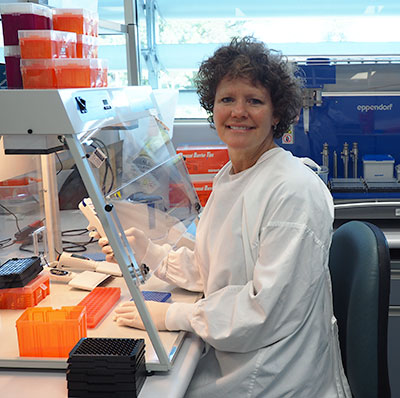 Dr. Sarah Palmer Scientists from the Westmead Institute for Medical Research in Australia have identified the specific immune cells in the body that harbor most of the HIV reservoir, the main barrier to a cure.
Dr. Sarah Palmer Scientists from the Westmead Institute for Medical Research in Australia have identified the specific immune cells in the body that harbor most of the HIV reservoir, the main barrier to a cure.
The study, which was partially funded by amfAR and published in the October 17 issue of Cell Reports, found that genetically intact and presumably replication-competent HIV hides in effector memory T cells, where it avoids detection by the immune system. These are the same white blood cells that “remember” previous infections and provide lifelong immunity to diseases such as chickenpox or measles. Replication-competent HIV DNA produces infectious particles.
“HIV is really very clever,” said amfAR-funded scientist Dr. Sarah Palmer, an associate professor at the University of Sydney and deputy director of the Centre for Virus Research at the Westmead Institute. “Essentially it is hiding in the exact same cells within the immune system that are meant to attack it.”
Palmer and her colleagues developed a next-generation genetic sequencing assay known as FLIPS (Full-Length Individual Proviral Sequencing) to determine where and how much replication-competent virus remained in six HIV-infected individuals on long-term antiretroviral therapy (ART). The assay measures intact HIV proviruses to deduce the amount of replication-competent virus in the body. Using the efficient, high-throughput technology, they discovered that about 70% of presumably replication-competent virus hides in specific subsets of CD4+ T cells.
Interestingly, the researchers found that only 5% of all HIV DNA present in these participants was genetically intact. (The other 95% was defective, i.e., noninfectious.) However, this small proportion hides in the effector memory T cells and is the likely source of viral rebound after ART cessation.
“This virus inserts its genome into the body's memory cells and sits there quietly avoiding detection by the immune system,” Palmer said. "These infected cells go into a resting state and stop producing HIV, but these latent cells can wake up and start making infectious HIV.”
Palmer said if a person stops taking ART, the virus that is hidden in effector memory T cells can return and start producing more HIV. The virus will spread throughout the body within weeks of stopping ART, she said.
She concluded: “Now that we’ve identified where the replication-competent virus is hiding, we can start work towards targeting these cells with new therapies aimed at fully eliminating HIV from the body.”
See also: Scientists find where HIV 'hides' to evade detection by the immune system